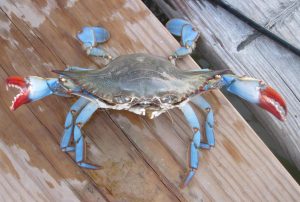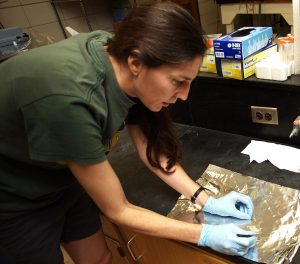Study Provides 1st Large-Scale Blue Crab Transcriptome Resource for Insights into Oil Exposure
– DECEMBER 21, 2016
Louisiana scientists conducted genetic sequencing on oil-exposed blue crabs to identify genes involved in the blue crabs’ short-term responses to oil. They found approximately 200 genes were significantly up- or down-regulated in gill and hepatopancreatic tissues and about 4,000 genes differed in how their transcripts were spliced together after oil-exposure. The gene expression changes suggest that broad physiological changes may result from oil exposure. This research also revealed new candidates for genes that detoxify and metabolize oil-derived compounds. The authors published their findings in BMC Genomics: De novo assembly of a transcriptome from juvenile blue crabs (Callinectes sapidus) following exposure to surrogate Macondo crude oil.
The Deepwater Horizon spill contaminated northern Gulf of Mexico marsh habitats with dispersed crude oil where the blue crab (Callinectes sapidus), an economically important species that supports a national commercial fishery, live. Previous studies on oil’s effects on crustacean gene expression have been limited to a small number of stress-response genes for a few brachyuran crab species.
This study’s experiment used juvenile blue crabs so that exposures could be conducted in relatively small volumes (3 liters) of water. The researchers used an oil concentration of 2.5 parts per million to produce a stress response that would not be lethal. After the exposure experiments, the team extracted RNA samples from eight juvenile blue crabs (half treated with oil), copied the RNA to DNA, and analyzed the mixtures of DNA sequences using Illumina sequencing.
Over 174 million sequences resulted in 73,400+ assembled transcripts grouped across 52,500+ genes. The researchers compiled the sequencing data into a transcriptome (the set of messenger RNA molecules in cells) and validated it against existing partial sequences for five protein-coding genes. They identified many alternatively-spliced transcripts (where a single gene codes for multiple proteins) in the blue crab transcriptome. Two newly-identified candidates for detoxification and metabolism of oil-derived compounds are genes that also process and metabolize foreign compounds in humans. The team cautioned that patterns of gene expression must be carefully interpreted to avoid confusing treatment effects from other sources of transcriptomic variation.
The sequences generated by this study can contribute to future ecological, biochemical, and population research on differential gene expression or genetic markers. The authors suggested that future studies investigate the potential that widespread differential splicing in response to oil exposure could prevent the translation of genes not immediately involved in stress responses.
Data are publicly available through the Gulf of Mexico Research Initiative Information & Data Cooperative (GRIIDC) at R3.x175.000:0002 and R2.x214.000:0002.
The study’s authors are Bree K. Yednock, Timothy J. Sullivan, and Joseph E. Neigel.
************
This research was made possible in part by a grant from the Gulf of Mexico Research Initiative (GoMRI) to University of Louisiana at Lafayette Department of Biology for the project The Environmental Effects of an Oil Spill on Blue Crabs in the Gulf of Mexico and the Dynamics of Recovery: Integrating Oceanography and Molecular Ecology.
The Gulf of Mexico Research Initiative (GoMRI) is a 10-year independent research program established to study the effect, and the potential associated impact, of hydrocarbon releases on the environment and public health, as well as to develop improved spill mitigation, oil detection, characterization and remediation technologies. An independent and academic 20-member Research Board makes the funding and research direction decisions to ensure the intellectual quality, effectiveness and academic independence of the GoMRI research. All research data, findings and publications will be made publicly available. The program was established through a $500 million financial commitment from BP. For more information, visit https://gulfresearchinitiative.org/.
© Copyright 2010-2017 Gulf of Mexico Research Initiative (GoMRI) – All Rights Reserved. Redistribution is encouraged with acknowledgement to the Gulf of Mexico Research Initiative (GoMRI). Please credit images and/or videos as done in each article. Questions? Contact web-content editor Nilde “Maggie” Dannreuther, Northern Gulf Institute, Mississippi State University (maggied@ngi.msstate.edu).







